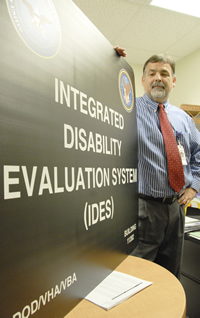By Sandra Basu

Daniel Barnes, physical evaluation board liaison officer lead at the Integrated Disability Evaluation System Center on Fort Bliss, TX, glances at a new sign for the IDES center. Army Medicine photo by Jennifer Clampet
WASHINGTON—The time for injured and ill servicemembers to get through the Integrated Disability Evaluation System process from their date of referral to their notification of benefits has been slashed more than half in the last decade.
DoD said the time frame now is an average of 250 days, a dramatic drop from an average of 540 days prior to implementation of the system in 2007.
“The IDES framework continues to exceed expectations,” said Terry Adirim, MD, DoD deputy assistant secretary of Defense for Health Services and Policy Oversight.
Adirim made her comments at a subcommittee hearing on IDES, which was created to eliminate the duplicate medical examination and rating determinations within DoD and VA for troops who have conditions that make them unable to perform their military duties. The system provides a single set of disability examinations and a single-source disability rating that are used by both departments.
In FY 2017, more than 22,000 veterans and military personnel were enrolled in the IDES program.
Willie C. Clark, deputy under secretary for field operations at the Veterans Benefits Administration (VBA), told lawmakers that VA’s portion of the IDES process now takes an average of 81 days, which is 102 days faster than when the subcommittee held a hearing on the topic in May 2014.
“VA continues to collaborate with DoD on ways to improve the IDES execution while remaining focused on timeliness and accuracy,” Clark pointed out.
Better Coordination
Lawmakers acknowledged the improvements. House Committee on Veterans’ Affairs Disability Assistance and Memorial Affairs Subcommittee Chairman Rep. Mike Bost (R-IL) noted that, at the 2014 hearing, advocacy groups expressed concerns they had about the quality of disability examinations, accuracy of ratings and the length of the IDES.
Servicemembers he recently spoke with at Walter Reed National Military Medical Center, Bethesda, MD, had “no complaints” about IDES, but Bost said “that doesn’t mean that the program can’t be improved upon.”
Subcommittee Ranking Member Rep. Elizabeth Esty (D-CT) added that “the most important element that we’ve seen in making improvement is, in fact, better coordination between the DoD and VA.”
“That’s not easy to do, but it’s essential if we’re going to continue to make progress,” Esty emphasized.
Still, she expressed concern about troops who do not connect with VA, falling between the cracks after leaving DoD. She said that getting accurate e-mail addresses is “unbelievably important” to stay in touch with transitioning troops, particularly because they may be moving around and difficult to find. “This leads to a whole host of problems. It seems to me vital that we figure out a way to capture as best we can their email addresses,” she said.
Clark agreed that reaching transitioning troops is “an opportunity for improvement.” He pointed to VA’s Transition Assistance Program, which helps servicemembers transition and learn about their VA benefits.
“We need to do a better job. One servicemember who does not get the word is one servicemember too many,” he said.
Advocacy groups also weighed in on the issues. The American Legion’s Gerardo Avila said that “the current IDES system is an improvement over its predecessor.” The American Legion continues to be concerned, however, that DoD gives exams and ratings for troops who are put on what is known as the Temporary Disability Retired List.
“Going forward, let’s use one rating,” Avila urged. “If we start changing ratings, and we have different ratings between DoD [and VA], then we are going back to the old system, and that was the change with IDES that we would have one rating decision, and it would be used by both DoD and VA.”
Clark said that VA would have to work with DoD to be able to take that over, explaining, “As it presently stands it is a DoD responsibility.”
Ryan Gallucci, Veterans of Foreign Wars national veterans service director, also testified about concerns regarding changes VA made to its predischarge claims programs, including eliminating the Quick Start (QS) claims program. This program allowed troops who have 59 or fewer days left on active duty to file claims. VA also shifted its timelines for the Benefits Delivery at Discharge program, only allowing servicemembers to submit their BDD claims from 180—90 days prior to discharge.
“In visiting with our pre-discharge claims sites, we hear that most clients visit our offices with far fewer than 90 days left on active duty, meaning most of our past BDD clients would no longer be qualified for the program,” Gallucci wrote in a statement. “Yes, VA still accepts these claims, but they are no longer processed expediently while the veteran still serves on active duty.”

